The recount trial, part 1: Coleman sues
Go Deeper.
Create an account or log in to save stories.
Like this?
Thanks for liking this story! We have added it to a list of your favorite stories.

As promised, Norm Coleman quickly took the battle to the next level.
Surrounded by cheering supporters packed into a State Office building room, Norm Coleman announced he was suing to challenge the outcome of the recount.
"As of today, not every valid vote has been counted and some have been counted twice. So today I'm announcing that I'm instructing my legal team to file an election contest, according to Minnesota law," he said.
LAWSUIT SEEMED INEVITABLE
Turn Up Your Support
MPR News helps you turn down the noise and build shared understanding. Turn up your support for this public resource and keep trusted journalism accessible to all.
Coleman and Franken essentially switched positions from the recount to the lawsuit. Behind in the vote tally, it was now Coleman, not Franken, who called for the inclusion of thousands more rejected absentee ballots.
It was now Coleman alleging that many Minnesotans who voted by absentee ballot were disenfranchised, because their ballots were wrongly rejected.
[image]
From the time the recount began, there was consensus that whoever ended up losing would likely challenge the result in court. There was a lot at stake, and not just for the candidates -- also for the U.S. Senate and for the success or failure of President-elect Obama's agenda. Having even just one more Democrat or Republican in the Senate was a big deal to both parties.
A three-judge panel was chosen to hear Coleman's case and Franken's response. Like the Canvassing Board, which oversaw the recount, the judicial panel was politically diverse; one judge had been appointed by a Republican, another by a Democrat and the third by Independence Party Gov. Jesse Ventura.
Initially, attorneys told court officials they expected the case to take about five court days. But the trial dragged on for nearly two months.
THE CASE BEGINS
In his opening statement on Jan. 26, the first day of the trial, Coleman attorney Joe Friedberg made comparisons between Minnesota and Florida. Friedberg argued that in the Minnesota election, different counties used different standards to decide which absentee ballots to count.

"What we are asking you to do is to do the best you can to level the playing field," said Friedberg. "We're going to ask you to do the best you can, after looking at these rejected ballots, to let in enough so that they are equal and approximately the same standard as was used on the ones that have come in. There's about 5,000 of them that we're dealing with."
In his opening statement, Franken attorney Kevin Hamilton feigned astonishment that Coleman, who had argued against adding any rejected absentee ballots to the recount, now wanted thousands of them opened and counted.
"The contestant's radically inconsistent positions with respect to absentee ballots is stunning," said Hamilton. "First, contestant opposed the consideration of any absentee ballots and insisted that all of them -- every single one that had been initially rejected -- had been properly rejected and could not be reconsidered."

"This is the precise opposite of their current position. It's perfect symmetry, perfect inconsistency and a perfect contradiction," argued Hamilton.
In addition to wanting thousands of absentee ballots added to the count, Coleman was suing to remove alleged double-counted ballots from the recount tally.
He also wanted the three-judge panel to remove some 132 ballots from the recount that disappeared from a precinct in Minneapolis following the election, but that were still included in the recount using the election night voting machine numbers.
Go to: The recount trial, part 2




